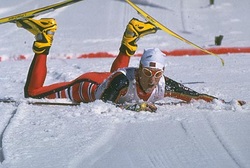History of Skis

Bjørn Dæhlie dominating for Norway
Skis that are used today in racing, training, and touring have not always been the way that they are. Today, they are made up of a mix of wood for the core, plastics and carbon fiber for the top sheet, and "p-tex" for the base layer. In the beginning, they were much more rudimentary being made up of just wood.
The oldest ski was found in Norway dating back to 5100 BC. These skis were just made of wood. They were only used for transportation. The first modern ski was made in the middle of the 20th century. This was mainly due to the popularization of the winter Olympics and the search for better equipment. This Olympic boom produced the fiberglass ski, which was the first ski to use "p-tex" on the base. P-tex, which is a high-molecular-weight polyethylene, is used because it absorbs ski wax, which increases glide on the skis by melting the snow. Choosing the wax is important because the amount of friction depends on the different snow temperatures and types. The least amount of friction, the faster the skis will be.
Structure was incorporated into skiing in the 1990s. Because of its unknown importance at the time, the Norwegians began to understand that if they can understand the concept of structure, they will be able to dominate the skiing world. Norway was indeed the dominating country in skiing of the 90s and not until other countries learned how to stone grind, were they pressured for the top spot in skiing.
The oldest ski was found in Norway dating back to 5100 BC. These skis were just made of wood. They were only used for transportation. The first modern ski was made in the middle of the 20th century. This was mainly due to the popularization of the winter Olympics and the search for better equipment. This Olympic boom produced the fiberglass ski, which was the first ski to use "p-tex" on the base. P-tex, which is a high-molecular-weight polyethylene, is used because it absorbs ski wax, which increases glide on the skis by melting the snow. Choosing the wax is important because the amount of friction depends on the different snow temperatures and types. The least amount of friction, the faster the skis will be.
Structure was incorporated into skiing in the 1990s. Because of its unknown importance at the time, the Norwegians began to understand that if they can understand the concept of structure, they will be able to dominate the skiing world. Norway was indeed the dominating country in skiing of the 90s and not until other countries learned how to stone grind, were they pressured for the top spot in skiing.